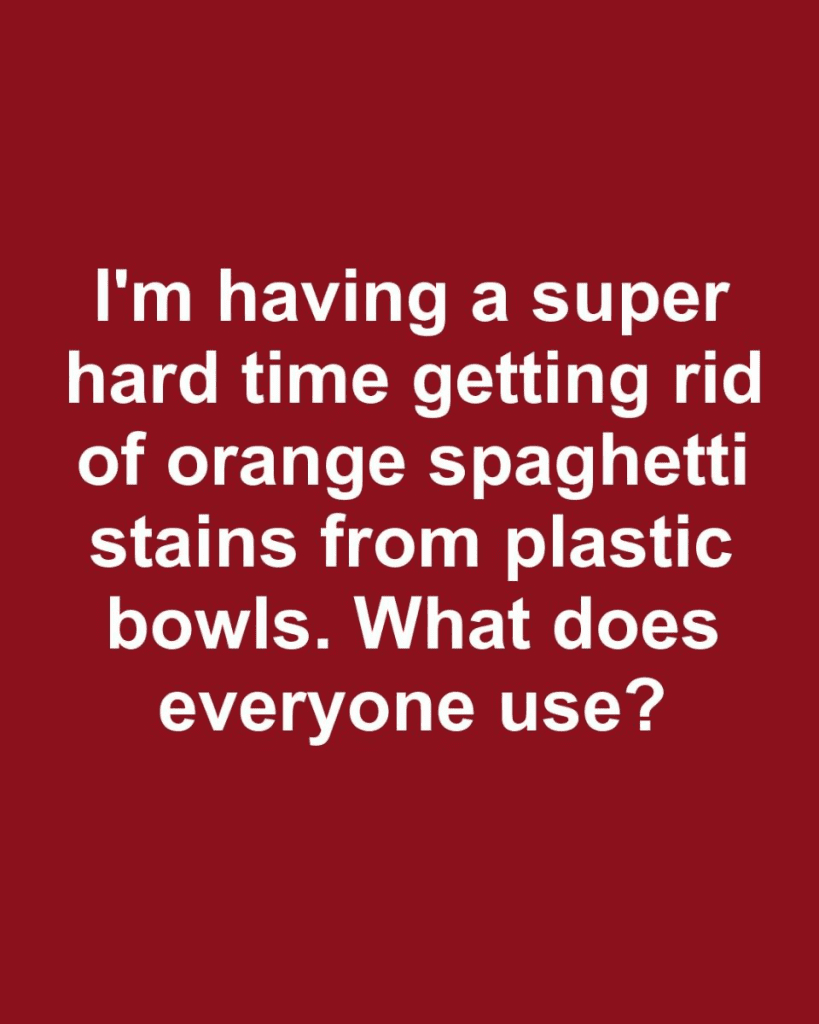Nothing says comfort food quite like a big plate of spaghetti, but the aftermath—those stubborn orange stains on your plastic bowls—can be a nightmare. Rich tomato sauces are notorious for leaving an unsightly tint on plasticware, and simple soap and water just don’t seem to cut it. Why is this such a common issue, and what can you do to prevent it? This guide will explore the science behind tomato stains, tried-and-true cleaning methods, and practical ways to keep your plastic bowls looking fresh and clean.

Understanding Why Plastic Stains So Easily
Plastic is a favorite in many kitchens due to its affordability and durability, yet it’s also highly prone to staining. This is because plastic, especially the types used in cheaper kitchenware, is porous. Tiny imperfections on the surface can trap pigments and oils from food.
The Chemistry of Tomato-Based Stains
Tomato sauces contain carotenoids, specifically lycopene, which gives tomatoes their vivid color. These pigments are lipid-soluble, meaning they bond well with fats. When combined with the acidity in tomatoes, these pigments can latch onto plastic and penetrate the pores, creating a stain that can be hard to scrub away. This lipophilic and acidic combo is why tomato-based sauces are so effective at staining plastic, unlike many other types of food.
Pre-Treatment Techniques for Stubborn Stains
Before tackling the stain with heavy-duty cleaners, a little pre-treatment can make a world of difference.
1. Rinse with Cold Water Immediately
Once you’ve finished your meal, rinse the bowl with cold water right away. Cold water helps prevent the pigment from setting into the plastic, while hot water can cause the pores to expand and absorb more of the sauce.
2. Apply a Baking Soda Paste
Baking soda is an excellent natural cleaner. Mix it with a small amount of water to create a paste, then apply it directly to the stained areas. Let it sit for several hours or, for tough stains, overnight. Baking soda’s mild abrasiveness helps lift stains from the surface without damaging the plastic.
3. Use a Vinegar Soak
Vinegar can also help dissolve lingering residues. Soak the plastic bowl in a mixture of equal parts vinegar and water for about 30 minutes before washing it with dish soap. The acidity in vinegar works to break down the stain and make it easier to clean.
Choosing the Right Cleaning Agents for Plastic
When dish soap doesn’t do the trick, it may be time to consider stronger cleaning agents. Here are some effective options for tough stains on plastic:
1. Oxygen Bleach for Deep Cleaning
Oxygen bleach is a powerful stain remover that’s non-abrasive, making it a safe option for plastic. Dissolve a small amount in water and soak the plastic bowl for an hour or so. Remember to rinse thoroughly to remove any residue.
2. Specialized Plastic Cleaners
There are various cleaning products specifically designed for plastic. These are formulated to break down stubborn food stains without scratching or damaging the material. Look for products labeled as safe for plasticware and follow the instructions for the best results.
3. Dish Detergent with a Dash of Bleach
A little bleach mixed with dish detergent can also work wonders. Add just a drop or two of bleach to a bowl of soapy water and soak the plastic for about 15-20 minutes. Ensure you rinse the bowl thoroughly afterward to remove any bleach residue.
Household Remedies for Tomato Stains
Household remedies can be surprisingly effective, and they’re often safer for both your plasticware and the environment. Here are some common methods:
1. Lemon Juice for Natural Bleaching
Lemon juice’s acidity makes it a natural bleaching agent. Squeeze fresh lemon juice over the stained area, let it sit for a few hours, and rinse. The acid can help break down the stain without the need for harsh chemicals.
2. Sunlight as a Natural Bleach
If the stain persists, try placing the plastic bowl in direct sunlight. UV rays have a natural bleaching effect that can gradually lighten and fade stains. This method may take some time but is eco-friendly and requires zero scrubbing.
3. Baking Soda and Vinegar Mix
This powerful combination is great for stubborn stains. Sprinkle baking soda over the stained area and add a little vinegar. The foaming reaction can help lift the pigment from the plastic. Once the fizzing stops, scrub gently with a sponge and rinse.
Innovative Solutions and Gadgets for Cleaning Plastic
For those looking to get more high-tech with their cleaning, there are a few gadgets worth considering.
1. Ultrasonic Cleaners for Small Kitchen Items
Originally used for jewelry, ultrasonic cleaners can be repurposed to clean plastic bowls. These devices create high-frequency sound waves that agitate water, which helps remove particles and stains from even the smallest crevices.
2. Steam Cleaners for Tough Residue
Steam cleaners use high-temperature steam to soften and lift residue embedded in plastic. They’re particularly effective for stubborn, greasy stains and are a chemical-free option.
3. Stain Eraser Pads
Specialized eraser pads designed for plastic stains are an easy and affordable tool. They use micro-abrasives to scrub away stains without scratching the surface. These are especially useful for deep-seated stains and can be found in most household stores.
Preventative Measures to Avoid Future Stains
Prevention is always better than cure, and a few small changes can make a big difference in keeping your plasticware stain-free.
1. Apply a Thin Layer of Oil
Applying a tiny amount of oil to the inside of the bowl before adding tomato-based foods can act as a barrier, preventing pigments from bonding with the plastic. Make sure to wipe off any excess oil before use.
2. Choose Glass or Ceramic for Stain-Prone Foods
Whenever possible, use glass or ceramic dishes for foods with strong pigments, like tomato sauces and curries. Glass and ceramic are non-porous and won’t absorb stains, making them an ideal choice for stain-prone meals.
3. Promptly Rinse and Clean
Rinsing your plastic bowls as soon as possible after use can prevent stains from setting in. Once a stain has had time to settle, it becomes much harder to remove.
Eco-Friendly Considerations When Cleaning Stains
While tackling tough stains, it’s also important to consider the environmental impact of your cleaning methods. Heavy-duty chemicals can be effective but may harm the environment if not disposed of properly. Natural remedies like vinegar, baking soda, and lemon juice tend to have a smaller environmental footprint, making them a better choice for eco-conscious households. Opting for biodegradable and environmentally-friendly cleaning products can also minimize your ecological impact.
Conclusion: Finding the Right Method for Your Kitchenware
Keeping your plastic bowls clean and stain-free doesn’t have to be an endless battle. Understanding the science behind tomato stains and exploring various cleaning options can make a world of difference. Whether you choose household remedies, specialized cleaning agents, or innovative gadgets, there’s a solution out there to suit your needs. With a little patience and experimentation, you’ll soon have plastic bowls that look as good as new, ready for your next spaghetti night.


